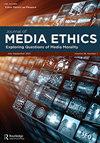“We All Know It’s Wrong, But…”: Moral Judgment of Cyberbullying in U.S. Newspaper Opinion Pieces
IF 1.1
3区 哲学
Q3 COMMUNICATION
引用次数: 1
Abstract
ABSTRACT This study uses the theory of dyadic morality to analyze construction of cyberbullying as a contested social issue in U. S. newspaper opinion pieces. The theory of dyadic morality posits that when we claim harm, we are motivated to identify a cause of harm and a suffering victim. This moral triangulation indicts determinants of harm and suggests preferred solutions. Analysis of U.S. opinion writing identified a tension between perception of cyberbullying as epidemic and the belief that some aggression was normative, that harm from speech was suspect, and that concern about cyberbullying was overblown. Cyberbullying served as a politically charged example of how technology is shaping adolescent social life and mental health; or how claims to victimhood are threats to free speech. Attention to moral dyad constructs in editorials and opinion pieces can help identify how competitive frames assert claims of moral validity in constructing arguments.“我们都知道这是错的,但是……”:美国报纸评论文章中对网络欺凌的道德判断
摘要:本研究运用二元道德理论分析了网络欺凌作为美国报纸评论文章中一个有争议的社会问题的建构。二元道德理论认为,当我们声称受到伤害时,我们会被激励去识别造成伤害的原因和遭受伤害的受害者。这种道德三角分析指出了危害的决定因素,并提出了首选的解决方案。对美国舆论写作的分析表明,人们认为网络欺凌是一种流行病,而认为某些侵犯行为是规范的,认为言论的伤害是可疑的,认为对网络欺凌的担忧被夸大了,这两者之间存在紧张关系。网络欺凌是科技如何影响青少年社会生活和心理健康的一个充满政治色彩的例子;或者声称自己是受害者是对言论自由的威胁。关注社论和评论文章中的道德二元结构可以帮助确定竞争框架如何在构建论点时主张道德有效性。
本文章由计算机程序翻译,如有差异,请以英文原文为准。
求助全文
约1分钟内获得全文
求助全文

 求助内容:
求助内容: 应助结果提醒方式:
应助结果提醒方式:


